June 29, 2025

The article titled "7 Shaping ABA Examples to Enhance Behavioral Therapy Outcomes" presents effective strategies in Applied Behavior Analysis (ABA) therapy that significantly improve behavioral outcomes through shaping techniques.
It highlights the critical role of tailored interventions, including:
These methods systematically decompose complex behaviors into manageable steps, facilitating skill acquisition and fostering independence in individuals undergoing therapy.
The demand for Board Certified Behavior Analysts (BCBAs) is surging, highlighting a critical need for effective shaping techniques in Applied Behavior Analysis (ABA). These techniques are revolutionizing behavioral therapy, offering a structured pathway to foster positive change. As practitioners seek to enhance therapeutic outcomes, understanding and implementing effective shaping methods becomes paramount. Yet, the challenge lies in navigating the complexities of individual behaviors and tailoring interventions to meet diverse needs.
How can practitioners leverage these techniques not only to improve client engagement but also to ensure lasting behavioral transformations? By addressing these questions, we can explore how the right strategies can lead to significant advancements in therapeutic practices.
The demand for (BCBAs) is at an all-time high, making it crucial for professionals in the field to connect with the right job opportunities. Hire ABA serves as a specialized recruitment platform that bridges the gap between BCBAs and top-tier positions in Applied Behavior Analysis (ABA) therapy. By focusing on the unique needs of BCBAs, Hire ABA simplifies the job search process. This ensures that qualified professionals find roles that not only align with their expertise but also fulfill their career aspirations.
Consider the challenges you face in hiring the right talent. Hire ABA addresses these issues by streamlining the recruitment process, ultimately enhancing the overall quality of care provided in ABA therapy settings. The platform ensures that the right professionals are matched with the right positions, benefiting both job seekers and employers alike.
With Hire ABA, you can trust that your hiring needs will be met with precision and expertise. Join the ranks of successful organizations that have transformed their hiring practices and improved their service delivery. Don’t miss out on the opportunity to connect with the best talent in the field—explore Hire ABA today and take the first step toward elevating your team.
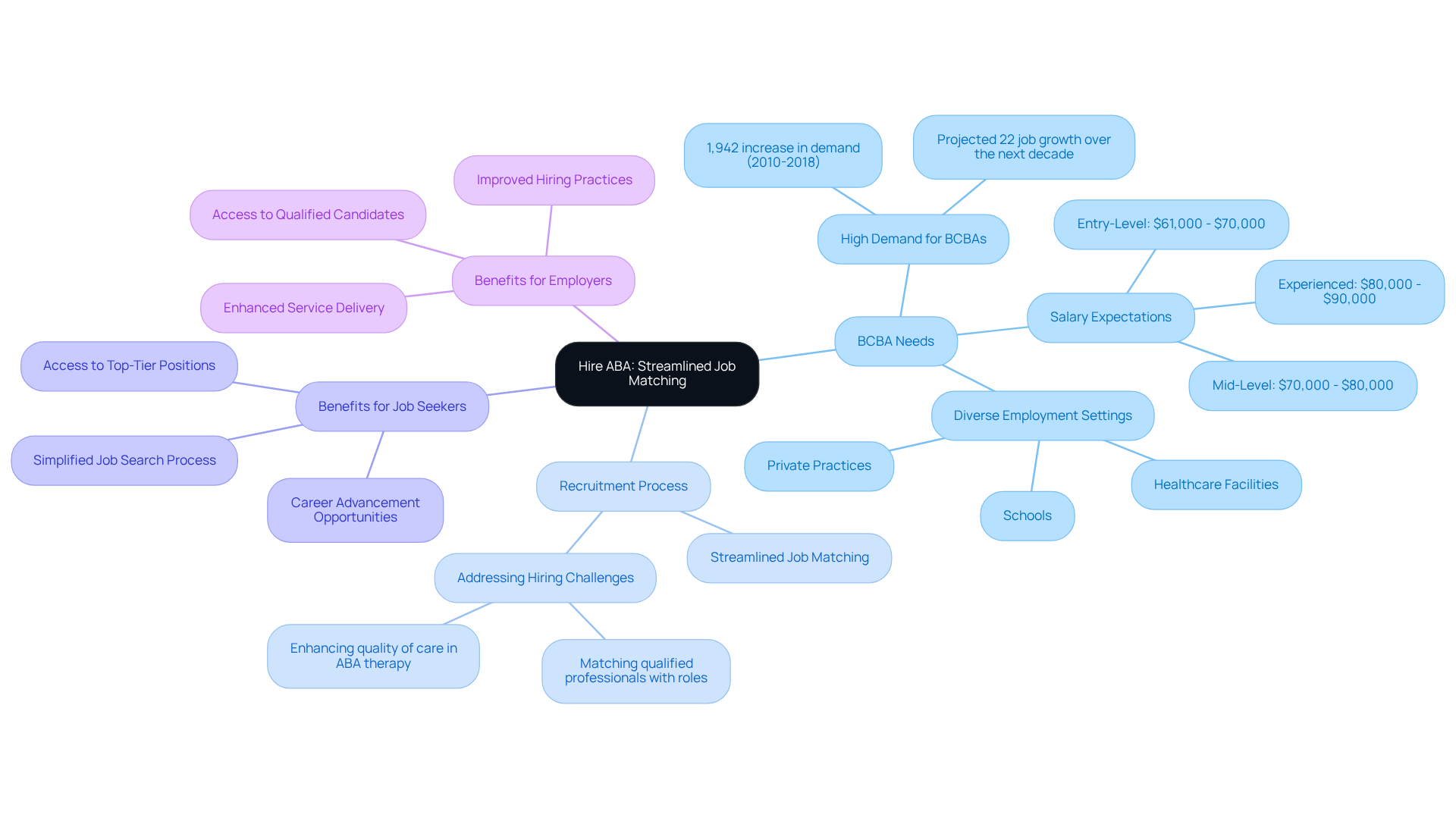
Differential support is a pivotal method in Applied Behavior Analysis (ABA) that involves encouraging desired actions while withholding support for unwanted activities. This approach is essential for shaping ABA example behavior, as it encourages individuals to adopt positive actions. For example, a Board Certified Behavior Analyst (BCBA) may reinforce a child for using appropriate language instead of shouting, thereby gradually enhancing their communication skills. Studies reveal that clients who receive motivational remarks during therapy experience a 30% increase in favorable behavioral outcomes, underscoring the importance of effective support strategies. By focusing on reinforcing positive behaviors, practitioners can systematically reduce maladaptive behaviors over time.
Moreover, research indicates that when recommended therapy hours are fully implemented with active caregiver participation, 90% of individuals show significant progress. This highlights the vital role caregivers play in the support process, as their involvement can substantially enhance the effectiveness of differential encouragement techniques. Continuous education and support for caregivers are also crucial, as mastering differential training techniques is an evolving journey that requires ongoing learning.
B.F. Skinner, acknowledged as the Father of ABA, established the foundational principles that guide these methods, emphasizing the importance of observable actions and reinforcement in achieving positive outcomes. Ultimately, the application of these strategies acts as a shaping aba example that not only but also fosters a supportive environment conducive to learning and development.
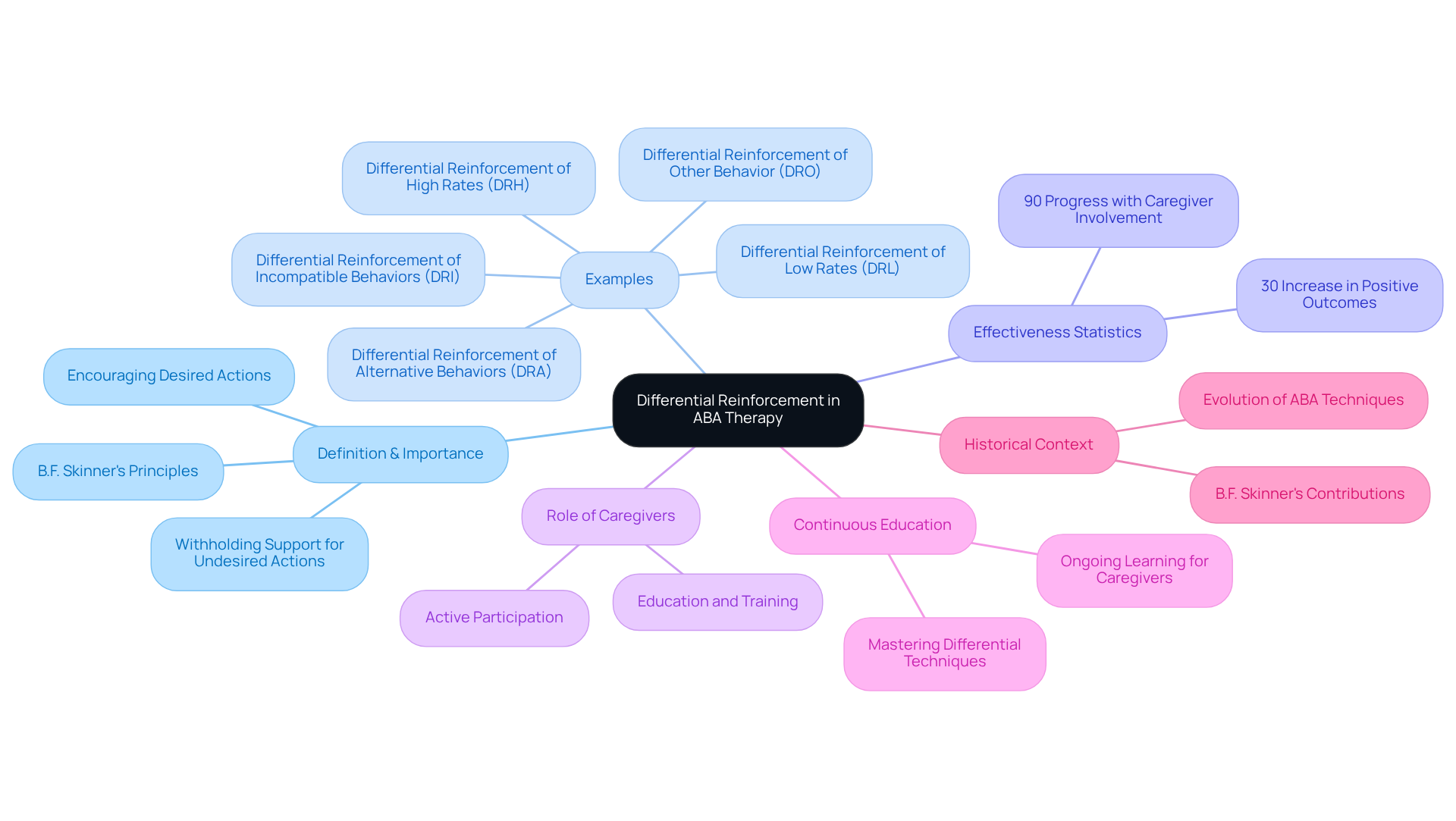
Sequential approximations are a cornerstone method in Applied Behavior Analysis (ABA), emphasizing the reinforcement of actions that gradually lead to the desired outcome. For instance, if the goal is for a child to say 'hello,' a Board Certified Behavior Analyst (BCBA) might initially reinforce any vocalization, then progress to rewarding the child for saying 'ha,' and ultimately for articulating 'hello.' This incremental approach not only fosters confidence but also keeps participants motivated as they witness their progress.
Research demonstrates that children involved in early, intensive therapy—typically around 25 to 40 hours weekly—often experience substantial developmental progress, with success rates exceeding 89% in various studies, bolstered by extensive research. The gradual nature of shaping ABA allows for that cater to individual needs, ensuring that goals are both achievable and appropriate for each child's skill level. As one BCBA aptly noted, 'Small steps lead to big changes in behavior,' a sentiment echoed among ABA professionals, highlighting the effectiveness of this approach in facilitating lasting behavioral change.
The advantages of employing gradual steps in shaping ABA are numerous. They encompass enhanced motivation, reduced frustration, and a clearer pathway to mastering complex skills. By deconstructing tasks into manageable components, therapists can cultivate a supportive environment that promotes learning and growth, ultimately resulting in improved communication, social skills, and independence for children with autism. Furthermore, it is essential to establish specific, measurable goals to avoid common pitfalls in the shaping process, ensuring that interventions remain focused and effective. Given the financial implications, full-time ABA therapy can incur costs around $115,200 annually, a significant consideration for healthcare employers when assessing the economic aspects of ABA services.
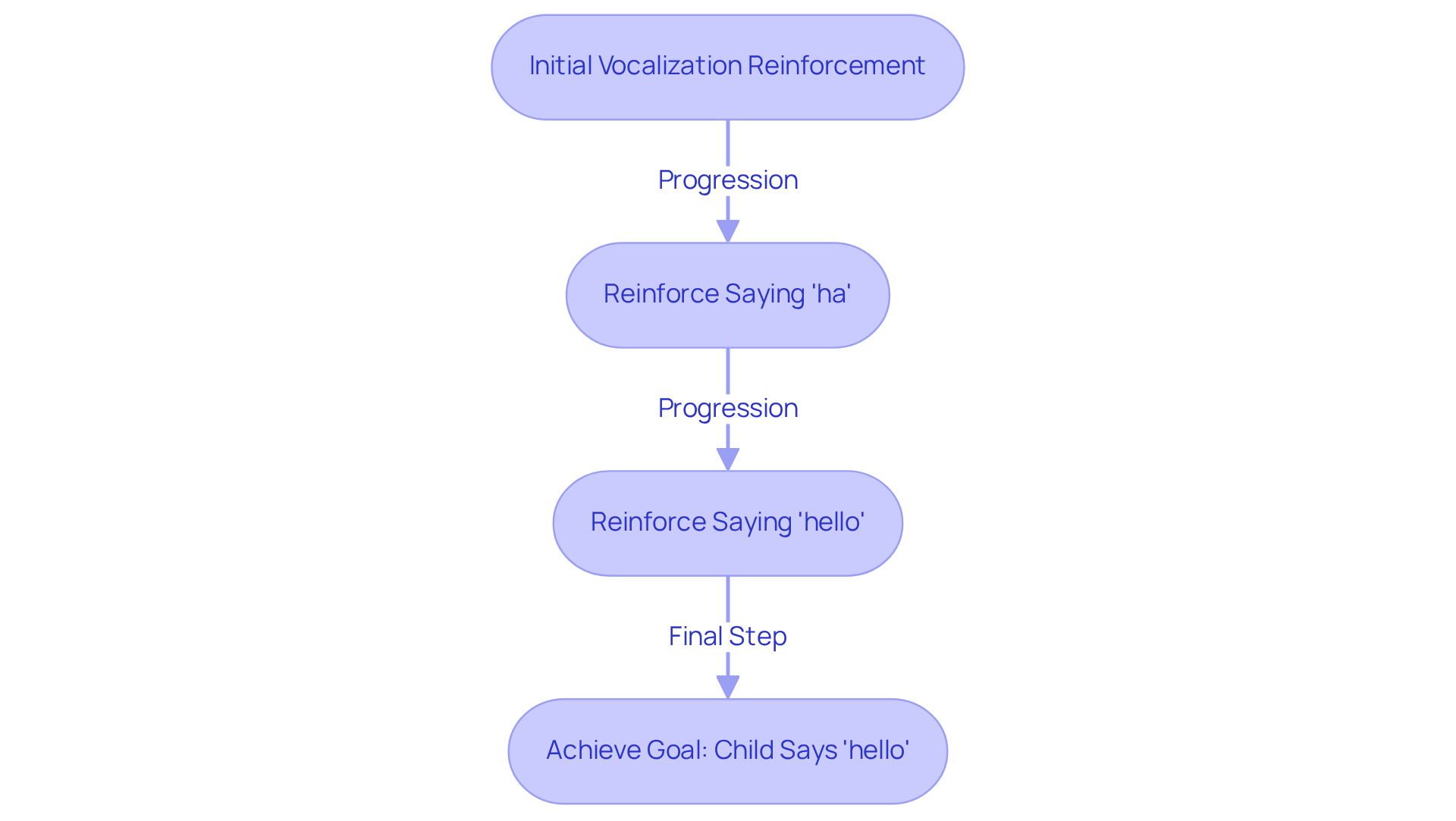
Teaching communication skills through a [shaping ABA example](https://behavioralinterventionforautism.com/blog/aba-therapy-success-rate-is-it-worth-it) is essential in the field of Applied Behavior Analysis. With the (BCBAs), it is crucial to implement effective techniques that enhance communication abilities. Techniques such as modeling and prompting serve as effective methods.
For instance, a BCBA might demonstrate a simple phrase, encouraging the individual to repeat it. As proficiency develops, the BCBA can gradually fade prompts, promoting independent communication. This practical approach not only enhances communication skills but also fosters independence in individuals.
Consider how these strategies can serve as a shaping ABA example that can be integrated into your practice to improve outcomes.
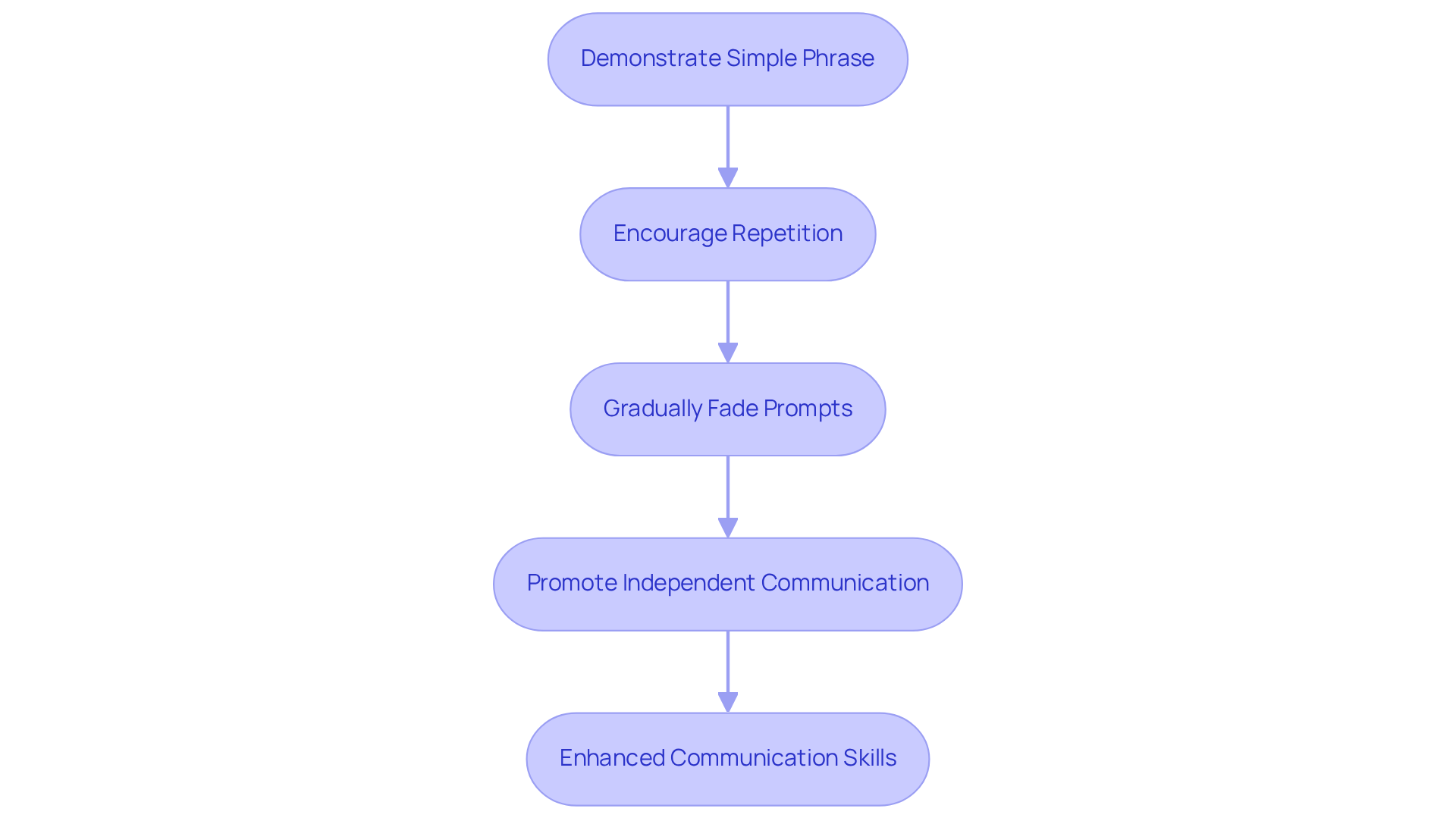
The demand for Board Certified Behavior Analysts (BCBAs) is projected to increase by 25% by 2026—an indicator of the growing need for effective ABA practices. Recognizing target actions is an essential initial stage in shaping ABA example techniques, which necessitates careful observation and analysis of a client's current patterns. This process allows practitioners to identify specific actions that require adjustment. For instance, if a child often interrupts during discussions, a BCBA may recognize 'waiting for a turn to speak' as the target action. By focusing on this particular behavior, the shaping ABA example can be adapted to encourage enhanced social interactions.
Studies reveal that interventions aimed at well-defined target actions yield notable enhancements. For example, children who undergo consistent ABA intervention frequently experience a decrease in disruptive actions, with aggressive occurrences dropping from an average of ten times daily to merely 2-3 following focused interventions. Furthermore, children who receive ABA therapy prior to turning five demonstrate significant advancements in communication, social skills, and adaptive capabilities, underscoring the importance of early intervention.
To enhance the effectiveness of shaping techniques, practitioners should consider utilizing as a shaping ABA example to accurately identify target behaviors. This comprehensive approach not only improves intervention outcomes but also ensures that the shaping process is tailored to meet the unique needs of each client. Are you facing challenges in hiring qualified BCBAs? Consider how Hire ABA can help you address these issues effectively.
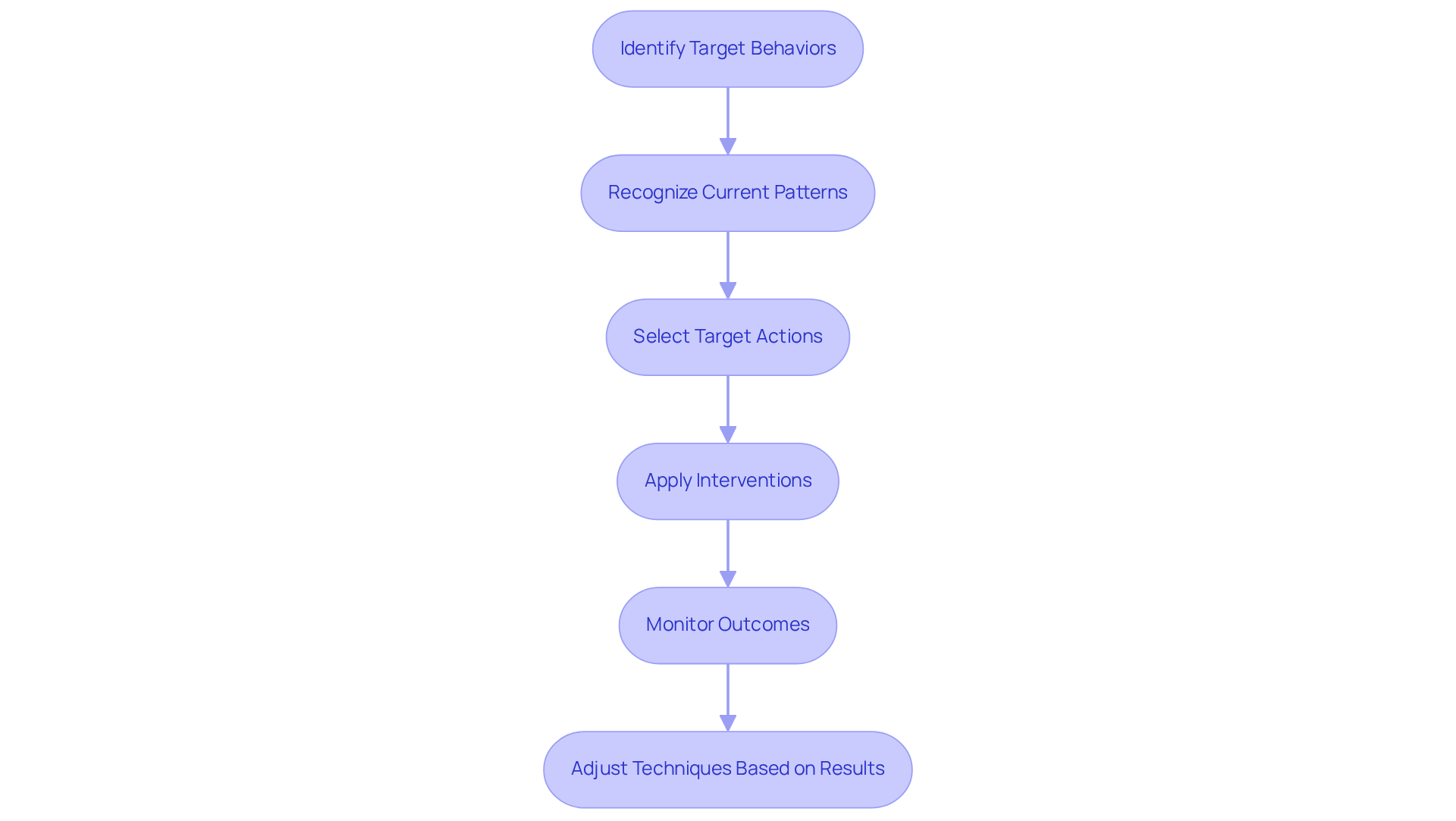
The demand for Board Certified Behavior Analysts (BCBAs) is projected to increase by 25% by 2026, underscoring the need for in the field of Applied Behavior Analysis (ABA). Efficient encouragement techniques are pivotal in enhancing the shaping ABA example within the shaping process. Positive reinforcement, which rewards favorable behaviors, and negative reinforcement, which involves the removal of an unpleasant stimulus after a desired action, are both essential methods. For example, a BCBA might implement a token economy system as a shaping ABA example to reward a child for completing tasks, thereby fostering ongoing engagement and effort.
Studies indicate that organized ABA programs significantly improve adaptive skills, enabling individuals to function more autonomously. Furthermore, ABA interventions have proven successful in reducing challenging behaviors such as self-injury, aggression, and repetitive actions. Recent research highlights the effectiveness of differential reinforcement techniques, particularly Differential Reinforcement of Alternative behaviors (DRA) and Differential Reinforcement of Other behaviors (DRO). DRA has demonstrated notable effectiveness when paired with extinction procedures, as shown by Volkert et al. (2009), leading to substantial reductions in challenging behaviors. Conversely, DRO reinforces the absence of undesired actions over specified intervals, promoting positive behavioral change.
Advancements in support techniques emphasize the importance of customizing strategies to meet individual client needs. For instance, prompt rewards can increase the likelihood of behavior repetition, while varied incentives help prevent satiation and maintain motivation. As the demand for BCBAs continues to rise, understanding and applying these nuanced reinforcement strategies will be essential for practitioners aiming for optimal outcomes in behavioral therapy. Additionally, diligent data collection is crucial for monitoring the effectiveness of these strategies, ensuring sustained progress and motivation.
Are you facing challenges in hiring qualified BCBAs? Consider how Hire ABA can address these issues effectively.
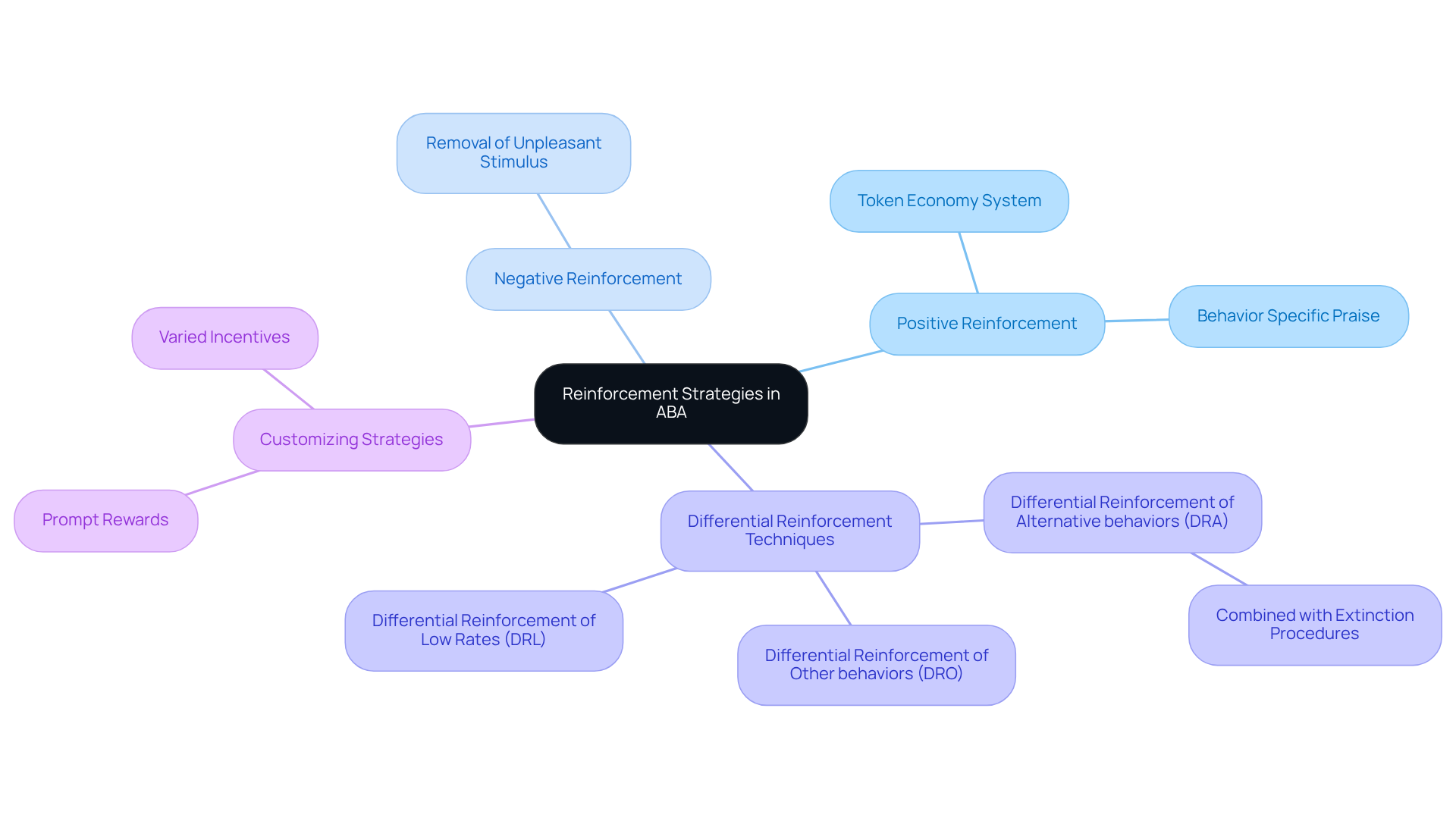
An effective shaping ABA example in Applied Behavior Analysis (ABA) relies on deconstructing intricate actions into manageable, attainable elements. For instance, when teaching a child to tie their shoes, a Board Certified Behavior Analyst (BCBA) may break down the task into sequential steps: first, grasping the laces, then crossing them, and finally forming a loop. This simplification enables users to experience success at each stage, fostering confidence and encouraging further learning.
Statistics indicate that ABA interventions produce an impressive success rate, with over 89% of individuals demonstrating progress in targeted actions. Furthermore, a meta-analysis reveals that 47% of children who underwent ABA therapy achieved normal intellectual and educational functioning, compared to just 2% in control groups. This highlights the effectiveness of ABA therapy as endorsed by the governments of Canada and the United States, which recognize it as a '' for treating children and youth with ASD.
To effectively simplify the shaping process, practitioners can employ several strategies:
By implementing these strategies, BCBAs can streamline the shaping ABA example process, ensuring that clients not only learn effectively but also enjoy the journey of acquiring new skills. Measurement is crucial in this process, as emphasized by H. James Harrington, who stated that measurement leads to control and ultimately to improvement.
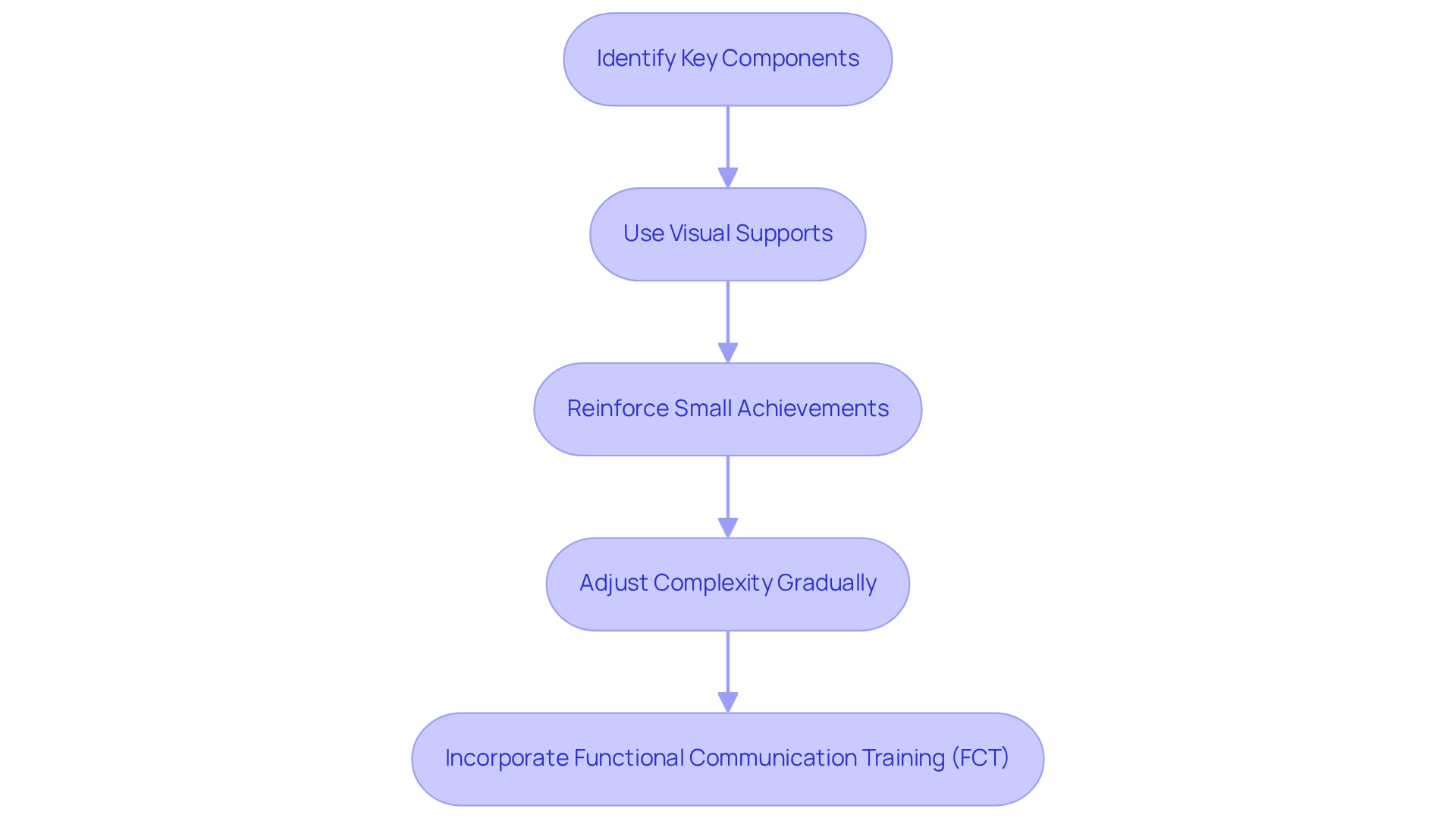
A shaping ABA example in therapy demonstrates essential techniques for developing social skills, particularly through role-playing and social stories. Did you know that the demand for Board Certified Behavior Analysts (BCBAs) is on the rise? For instance, a BCBA may implement role-playing exercises as a shaping ABA example to practice greetings, providing positive reinforcement each time a child successfully engages in this social interaction. This method not only strengthens the behavior but also in social situations.
Social stories are a shaping ABA example that serves as an effective resource, aiding individuals in understanding social cues and appropriate reactions in various scenarios. A case study titled 'Impact of Role-Playing on Conflict Resolution' illustrates that role-playing can significantly reduce negative behaviors, such as tattling, with incidents decreasing from an average of 12 to 7 among kindergarten students following intervention.
Moreover, role-playing cultivates meaningful relationships among students, enhancing their communication skills and conflict resolution abilities. Are you facing challenges in hiring qualified professionals for your ABA programs? By actively involving participants in social skills training, practitioners can foster a supportive environment that encourages empathy, effective communication, and problem-solving skills. This ultimately leads to improved outcomes in behavioral therapy. Consider how platforms like Hire ABA can assist in addressing your recruitment needs.
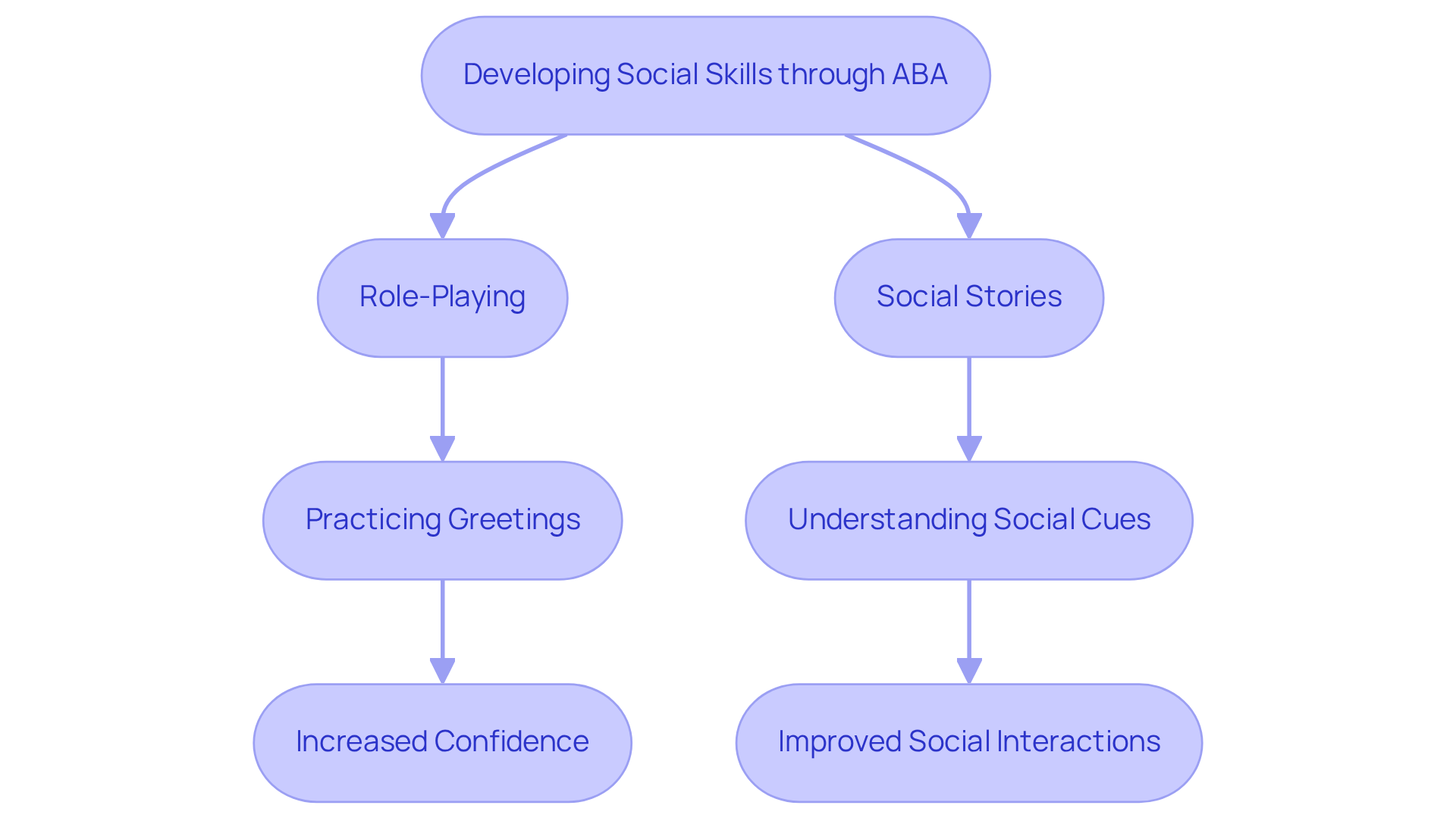
The demand for Board Certified Behavior Analysts (BCBAs) is projected to , underscoring the critical need for effective shaping ABA example techniques in Applied Behavior Analysis (ABA) therapy. Overcoming challenges in the shaping ABA example often necessitates a careful alteration of support strategies or modifications to target actions.
For instance, if a participant is unresponsive to a specific reward, the BCBA may need to investigate different kinds of incentives or enhance their frequency to elevate motivation. Furthermore, when a target behavior is too complex, breaking it down into smaller, more manageable steps can facilitate progress. This adaptability is essential; research suggests that shaping ABA examples through customizing support strategies can greatly improve the efficacy of interventions, with studies demonstrating a notable increase in participant engagement and results.
By maintaining a flexible approach and being attuned to the unique needs of each individual, practitioners can optimize their therapeutic interventions and foster meaningful behavioral change. Incorporating task boxes that target specific social skills provides practical applications of these strategies, further enhancing their effectiveness.
Quotes from supporters highlight the necessity for adaptability in support strategies, inspiring hope and resilience in both practitioners and those they assist. Additionally, the success of token economy therapy illustrates how adapting reinforcement strategies can lead to improved outcomes, reinforcing the importance of embracing neurodiversity in therapeutic practices.
Are you facing challenges in hiring qualified BCBAs? Consider how Hire ABA can address these issues and streamline your recruitment process.
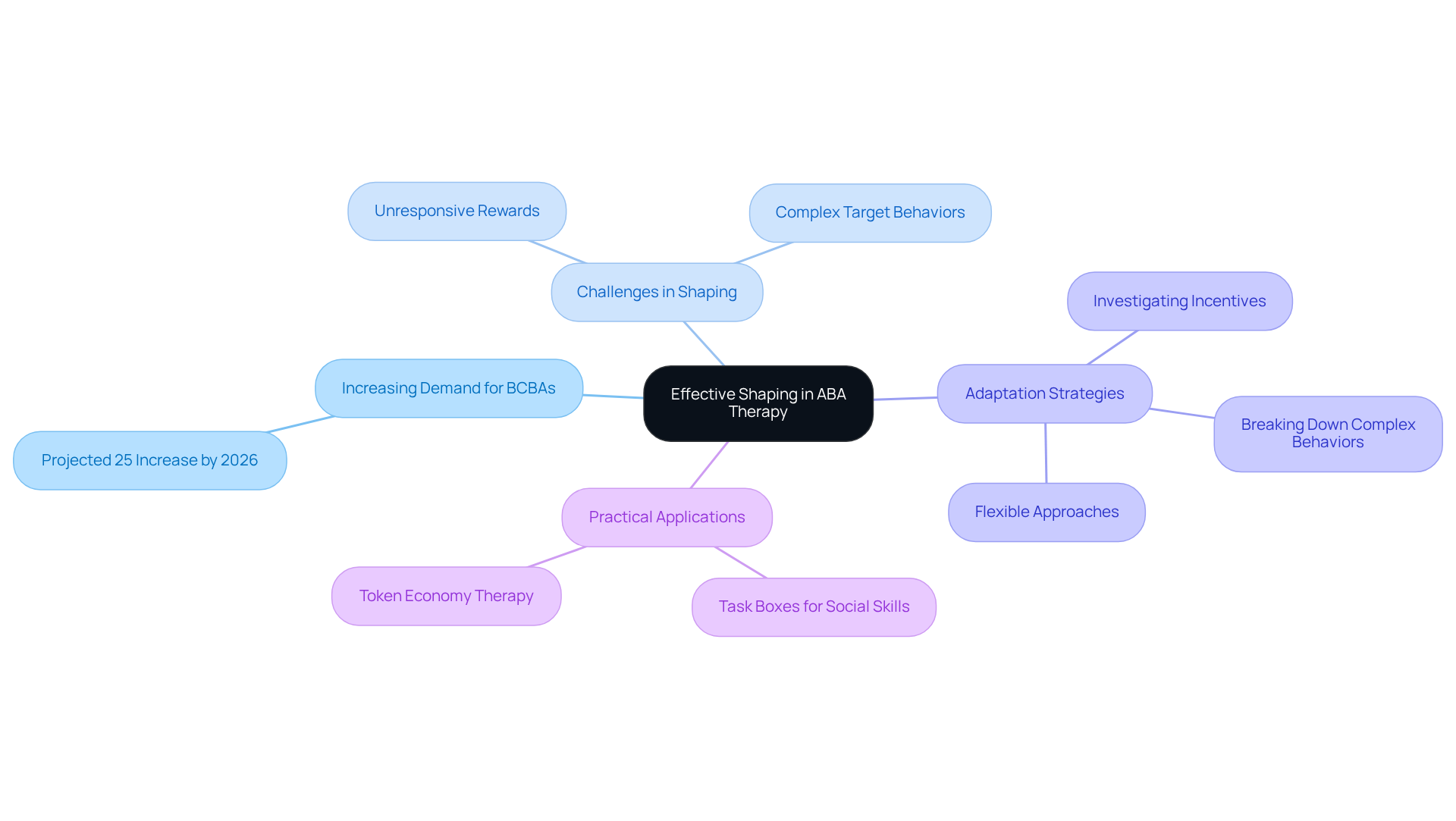
Shaping techniques have a profound impact on behavioral therapy outcomes, leading to the acquisition of new skills while promoting independence and self-regulation in individuals. By implementing tailored interventions that utilize various shaping strategies, Board Certified Behavior Analysts (BCBAs) can effectively address individual needs, significantly enhancing clients' quality of life. The systematic process of shaping involves breaking down complex actions into manageable steps, allowing for gradual reinforcement towards a target goal.
Research indicates that consistent application of shaping techniques results in notable improvements in behavior, communication, and social interactions. For instance, a case study demonstrated that preschool-aged children with Autism Spectrum Disorder (ASD) significantly improved their ability to maintain eye contact through shaping procedures, showcasing the effectiveness of these techniques in enhancing social engagement. This not only facilitates immediate behavioral changes but also contributes to long-term benefits, empowering clients to develop self-regulation skills that are essential for their independence.
As shaping techniques, including the shaping ABA example, continue to evolve, they remain a cornerstone of effective ABA therapy, driving meaningful progress for individuals with autism and other developmental challenges. As one expert noted, 'Defining precise behavioral goals is crucial in shaping interventions as it provides a roadmap for both therapists and individuals with autism to follow.
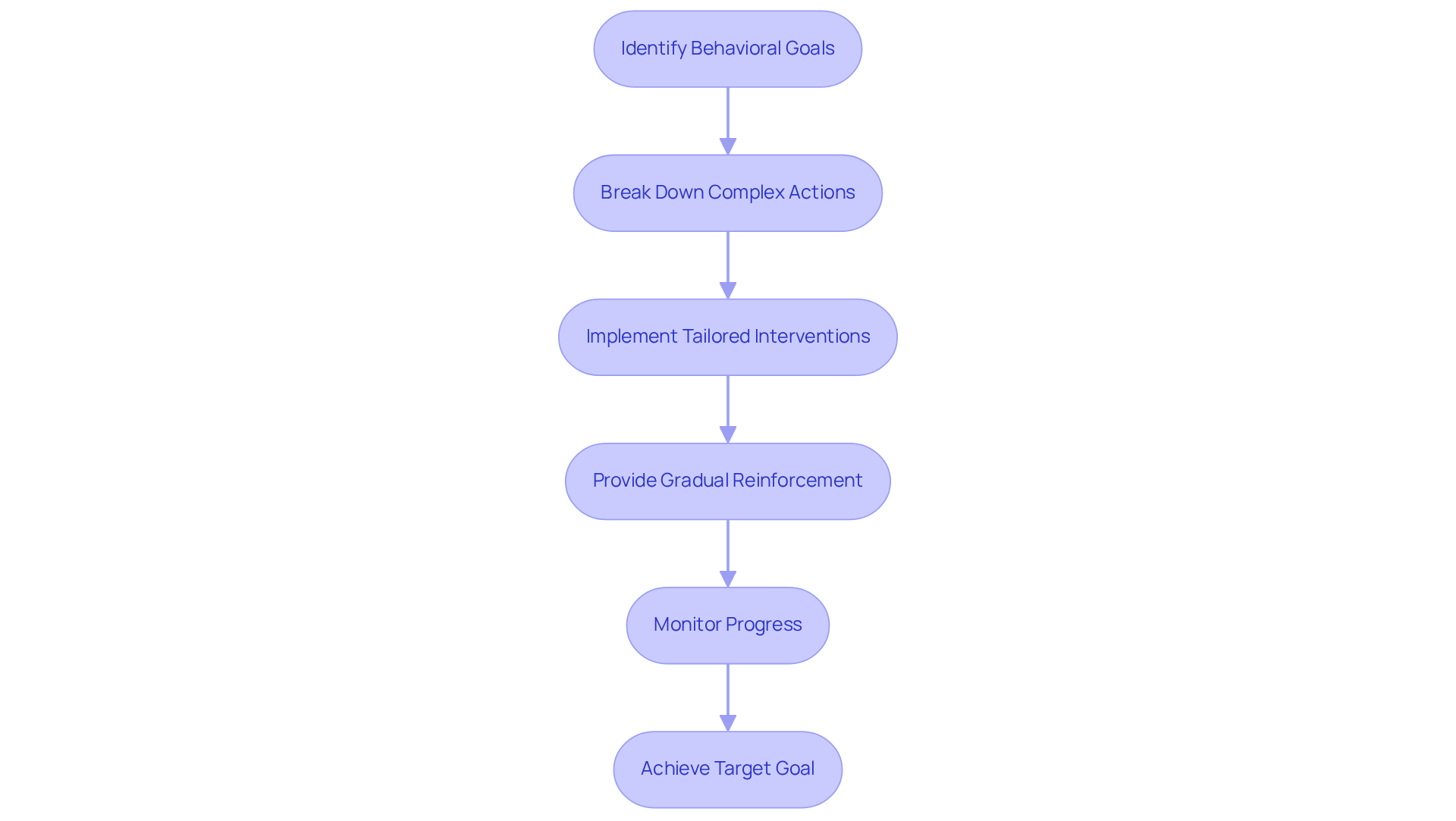
The demand for Board Certified Behavior Analysts (BCBAs) is on the rise, highlighting the critical need for effective recruitment strategies in the field of Applied Behavior Analysis (ABA). Shaping techniques play a pivotal role in enhancing the effectiveness of behavioral therapy, particularly by systematically breaking down complex behaviors into manageable steps. This approach fosters significant improvements in communication, social skills, and overall independence for individuals undergoing therapy.
Tailored interventions are essential, ensuring that each client's unique needs are addressed. This focus ultimately leads to better outcomes and a higher quality of life. Throughout this article, various shaping techniques were explored, including differential reinforcement and successive approximations, along with the importance of identifying target behaviors. Each method contributes to a structured approach that not only reinforces positive actions but also promotes gradual learning and development.
The data supporting these techniques underscores their effectiveness, with studies indicating substantial progress in clients' behaviors and skills when these strategies are implemented thoughtfully. As professionals in the field, it is crucial to stay informed about current trends and effective practices in shaping techniques. By embracing these methods and utilizing resources like specialized recruitment platforms, organizations can ensure they are equipped with the right talent to deliver high-quality ABA therapy.
The journey of implementing shaping techniques transcends immediate behavioral change; it is about empowering individuals to achieve lasting independence and self-regulation. Consider the challenges you face in hiring qualified professionals—how can Hire ABA address these issues? By prioritizing effective recruitment, you can transform lives for the better.
What is Hire ABA?
Hire ABA is a specialized recruitment platform that connects Board Certified Behavior Analysts (BCBAs) with job opportunities in Applied Behavior Analysis (ABA) therapy, streamlining the job search process for professionals in the field.
Why is Hire ABA important for BCBAs?
With the high demand for BCBAs, Hire ABA helps professionals find roles that align with their expertise and career aspirations, ensuring they connect with the right job opportunities.
How does Hire ABA benefit employers?
Hire ABA addresses hiring challenges by streamlining the recruitment process, which enhances the quality of care in ABA therapy settings by matching the right professionals with the right positions.
What is differential reinforcement in ABA therapy?
Differential reinforcement is a technique that encourages desired behaviors while withholding support for unwanted actions, helping shape positive behaviors over time.
How effective is differential reinforcement?
Studies show that clients receiving motivational remarks during therapy experience a 30% increase in favorable behavioral outcomes, highlighting the effectiveness of this support strategy.
What role do caregivers play in differential reinforcement?
Caregivers significantly enhance the effectiveness of differential reinforcement techniques, with research indicating that when they actively participate, 90% of individuals show significant progress.
What are successive approximations in ABA?
Successive approximations involve reinforcing gradual steps towards a desired behavior, allowing individuals to progress incrementally, such as moving from vocalizations to saying specific words.
What are the benefits of using successive approximations?
This method enhances motivation, reduces frustration, and provides a clearer pathway to mastering complex skills, fostering confidence and promoting learning for children with autism.
What is the financial consideration for full-time ABA therapy?
Full-time ABA therapy can incur costs around $115,200 annually, which is an important factor for healthcare employers to consider when assessing the economic aspects of ABA services.
Our expert recruitment strategies and AI-driven sourcing ensure that you receive top-notch candidates quickly, without compromising on quality. Whether you’re looking for BCBAs, Clinical Directors, or RBTs, we’ve got you covered.